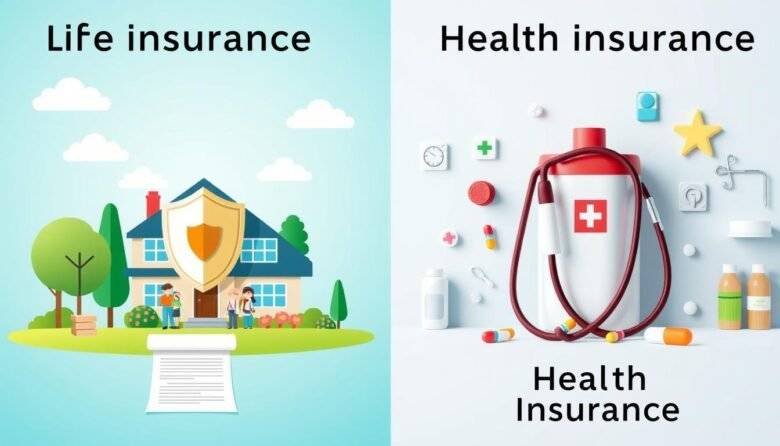Two main types of insurance are often talked about: life insurance and health insurance. Life insurance helps pay for funeral costs and other bills if you pass away. Health insurance, on the other hand, covers doctor visits and hospital stays.
Life insurance helps your loved ones financially if you die. Health insurance helps you pay for medical care without breaking the bank. Both are important for a complete insurance plan.
We’ll look at the main differences between life and health insurance. We’ll talk about what they cover, their benefits, and how much they cost. We’ll also see why you might need both.
Key Takeaways
- Life insurance provides financial protection to beneficiaries in the event of the policyholder’s death.
- Health insurance covers medical expenses, ensuring that individuals can receive the care they need without incurring significant debt.
- Understanding the difference between life insurance and health insurance is crucial to making informed decisions about insurance coverage.
- Both life insurance and health insurance are essential components of a comprehensive insurance strategy.
- Selecting the right insurance coverage depends on individual circumstances and needs.
- Cost factors and premium calculations vary between life insurance and health insurance.
Understanding the Basics of Insurance Coverage
Insurance comes in many types, each with its benefits. Life insurance and health insurance are two common ones. Knowing about these is key to choosing the right coverage.
Life insurance gives a death benefit to loved ones. Health insurance helps pay for medical bills. Both can be customized to fit your needs.
What is Life Insurance?
Life insurance pays out a death benefit. It can cover funeral costs, debts, and living expenses. There are two main types: term and whole life insurance. The term lasts a set time, while the whole is for life.
What is Health Insurance?
Health insurance pays for medical costs. It includes doctor visits, hospital stays, and prescriptions. It helps manage healthcare costs. There are individual and group plans available.
Core Purpose of Each Insurance Type
Life insurance and health insurance serve different purposes. Life insurance offers a death benefit. Health insurance covers medical bills. Premiums vary based on age, health, and lifestyle.
Choosing the right insurance depends on your needs. Understanding life and health insurance helps make informed choices. There are many options to fit different budgets and needs.
| Insurance Type | Benefits | Premiums |
|---|---|---|
| Life Insurance | Death benefit, financial protection | Varying costs based on age, health, and lifestyle |
| Health Insurance | Medical expense coverage, reduced healthcare costs | Varying costs based on age, health, and lifestyle |
Life Insurance vs. Health Insurance: What’s the Difference?
When comparing insurance, life insurance and health insurance are key. Life insurance gives a death benefit to loved ones if you pass away. Health insurance helps cover medical costs, so you don’t face huge bills.
Insurance comparison is vital to picking the right one. Life insurance offers a financial safety net, while health insurance covers medical costs. This way, you can protect your family and stay healthy without financial stress.
When deciding between life and health insurance, consider a few things:
- Age and health status
- Financial situation and dependents
- Current and future medical needs
Knowing the differences between life and health insurance helps you make a smart choice. A detailed comparison can guide you to the best insurance for your needs.
Coverage Details and Benefits
Understanding insurance coverage is key. Life insurance and health insurance offer different benefits. Life insurance provides a death benefit, cash value, and dividends. Health insurance covers doctor visits, hospital stays, and prescriptions.
Life insurance has important parts:
- Death benefit: a payout to the policyholder’s beneficiaries in the event of their death
- Cash value: a savings component that accumulates over time
- Dividends: a portion of the insurance company’s profits paid to policyholders
Policyholders can also add riders and benefits. These include long-term care, disability income, and accidental death benefits. They offer more insurance benefits and better coverage.
Knowing about life insurance and health insurance helps make smart choices. With the right policies, you can protect yourself and your loved ones. The right mix of coverage and riders gives you peace of mind.
| Insurance Type | Coverage Components | Riders and Benefits |
|---|---|---|
| Life Insurance | Death benefit, cash value, dividends | Long-term care, disability income, accidental death benefits |
| Health Insurance | Doctor visits, hospital stays, prescriptions | Long-term care, disability income, vision, and dental coverage |
Cost Factors and Premium Calculations
When it comes to life and health insurance, cost factors are key. They decide how much you’ll pay for your insurance premiums. Your age, health, and lifestyle all matter. Premium calculations look at your risk, coverage, and policy term.
Here are some main factors that affect insurance premiums:
- Age: Older people usually pay more because they face more health risks.
- Health: Those with health issues might pay more.
- Lifestyle: Activities like smoking can increase your premiums.
Knowing these cost factors helps you make smart choices about insurance. By understanding these, you can control costs and get the right coverage.
It’s crucial to compare insurance premiums and premium calculations from different providers. This way, you can find the best deal. You’ll get the right protection for you and your family while keeping costs in check.
| Factor | Impact on Insurance Premiums |
|---|---|
| Age | Higher premiums for older policyholders |
| Health | Higher premiums for policyholders with pre-existing medical conditions |
| Lifestyle | Higher premiums for policyholders who engage in high-risk activities |
When and Why You Need Both Types of Insurance
It’s important to have both life and health insurance at different life stages. Life stage considerations help decide the right insurance amount. For example, a young couple with kids might need more life insurance to protect their family’s future.
Financial planning is key when choosing insurance. A good financial plan helps manage money, save for the future, and protect assets. It also ensures family members are safe from unexpected costs.
Life Stage Considerations
Life stage considerations mean looking at your current life situation and insurance needs. This includes thinking about marriage, kids, or retirement. For instance, a person getting married might need more life insurance to protect their spouse.
Financial Planning Aspects
Financial planning involves making a detailed financial strategy that includes insurance. It’s about looking at income, expenses, assets, and debts to figure out insurance needs. A financial advisor can help create a plan that fits your unique situation and goals.
Family Protection Strategies
Family protection means making sure loved ones are safe from unexpected events. This includes having enough life insurance, health insurance, and other protections. A complete insurance plan gives peace of mind, knowing your family is secure, no matter your life stage.
| Life Stage | Insurance Needs |
|---|---|
| Single | Basic life insurance and health insurance |
| Married | Increased life insurance coverage and comprehensive health insurance |
| Retired | Long-term care insurance and Medicare supplement insurance |
By thinking about life stages, financial planning, and family protection, you can choose the right insurance. This ensures you and your loved ones are well-protected.
Making the Right Insurance Choice
Choosing the right insurance is crucial. It depends on your age, health, lifestyle, and money situation. Each of these factors affects what kind of insurance you need.
To pick the best insurance, think about what you need, how much you can spend, and how much risk you’re okay with. Here are some things to consider:
- Current health status and medical history
- Financial obligations, such as debts and dependents
- Lifestyle habits, such as smoking or extreme sports
- Occupation and work-related risks
By thinking about these points, you can choose the insurance that best protects you and your family. The right insurance gives you peace of mind and financial safety when unexpected things happen.
Conclusion
Understanding the differences between life and health insurance is key. A comprehensive insurance strategy is vital for your financial future and your family’s well-being. By combining both, you create a strong safety net. This helps protect your family and supports your long-term financial goals.
Creating an insurance strategy that fits your needs is essential. It’s important to regularly check and adjust your coverage as life changes. Having the right mix of life and health insurance gives you confidence in facing life’s challenges. A well-planned insurance portfolio does more than protect your assets. It ensures your family’s financial security and peace of mind.



